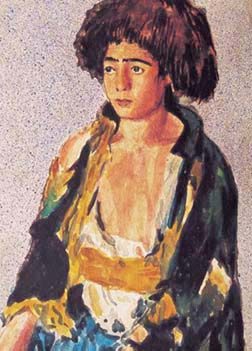|

Summer
1999 (7.2)
Page
26
Bahruz Kangarli
(1892-1922)
Azerbaijan's
Most Prolific Painter
by Ziyadkhan Aliyev
 During
the late 19th century, artists in Azerbaijan began moving away During
the late 19th century, artists in Azerbaijan began moving away
from the traditions of the Tabriz School of Miniature Art. Part
of this change in both style and form was due to the fact that
some Azerbaijani artists were studying European art. Bahruz Kangarli
(1892-1922) and Azim Azimzade (1880-1943), for example, used
techniques specific to European and Russian art.
Bahruz Kangarli was born in 1892. Though his name means "good
day," his life and his name contradicted each other. Bahruz
lived a short, difficult life and died at the young age of 30.
When he was only five or six years old, his mother died. At 10,
he became deaf as a result of an illness, which meant that he
had to stop going to school. Later, his father encouraged him
to study at home.
In spite of all these troubles, Bahruz developed a strong interest
in drawing. Bahruz wanted to study art, so he asked his father
to send him to Tbilisi where the only art school in Caucasus
existed at that time. In 1910, he successfully passed the entrance
exam and became the first Azerbaijani student to attend that
school.
His art teacher was a well-known landscape painter, Vasiliy Polenov.
Bahruz became greatly influenced by "Molla Nasraddin"
(the first Moslem satiric magazine, published in Tbilisi). After
studying five years there, Bahruz returned to Nakhchivan in 1915.
Bahruz Kangarli. One of the earliest known paintings of refugees
in Azerbaijan, around 1918.
There he began a career as an artist. He spent his time creating
works of art that glorified views of the city. He also painted
portraits of his contemporaries. As there was no Art Exhibition
Hall there, he had no place to show his work. So, he began organizing
exhibitions in his home. He loved to explain his works to visitors.
He also organized a painting circle for children to encourage
their interest in art. Even though Bahruz' life was very short,
he was, by far, Azerbaijan's most prolific artist. Over the course
of seven years of creative activity, he created close to 2,000
works of art.
Bahruz tried to paint everything as he saw it in real life. Most
of his works are landscape paintings. Previously, landscapes
had only been used as background material for other subjects.
With Bahruz, landscape paintings became a new genre in Azerbaijani
art.
It seems there was no mountain, plain, architectural monument,
lake or river in Nakhchivan or its environs that Bahruz did not
paint. Every day, early in the morning, he would take his bag
of paints and leave the house. In the evening he would return
home, carrying several landscape paintings. He liked to paint
on small canvases or pieces of paper. This small size gave him
the chance to show his impressions of nature in detail within
a short amount of time. "Autumn," "The Way Leading
to the Village," "A Flock of Sheep," "Trees,"
"Old Monument" and "The View of Nakhchivan"
are examples of these works.
Portraits
Bahruz
also enriched the genre of portraiture. He painted children of
all ages in watercolor (usually when they were sleeping). He
also painted a "refugees" cycle, depicting the Azerbaijanis
who had fled from Armenia and found refuge in Nakhchivan during
1918-1920. Titles of such works include "Barefoot Refugee,"
"The Refugee Boy from the Janfada Village of Yerevan,"
"Refugee Khanim" and "Refugees". People say
that when Bahruz would meet a refugee in the street, especially
if it were a child, he would take him home and feed him, despite
the fact that he was living under hard conditions himself. Then
he would paint the refugee's portrait.
In 1921, Bahruz held his only official exhibition. It was organized
in Nakhchivan by the government and included 500 works. By that
time, Bahruz was already very ill. On his deathbed, he decided
that the money from the exhibition should be given to orphans
in memory of his own situation when his mother had died. Bahruz
died in 1922; he was only 30 years old.
One of Bahruz' best works is currently on exhibition at the Moscow
State History Museum. Entitled "Nakhchivan Herald",
it depicts an Azerbaijani man on a horse with a gun in his hand,
with mountains in the background. The remainder of his works
are kept at the Azerbaijan State Art Museum in Baku and the Historical-Ethnographic
Museum in Nakhchivan.
From Azerbaijan
International
(7.2) Summer1999.
© Azerbaijan International 1999. All rights reserved.
Back to Index
AI 7.2 (Summer 99)
AI Home
| Magazine
Choice | Topics
| Store
| Contact
us
|